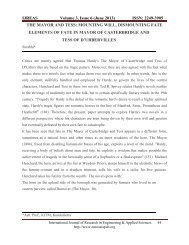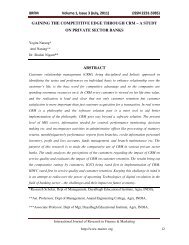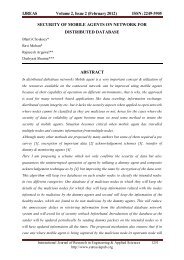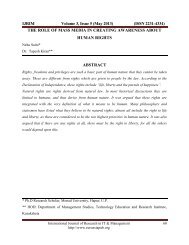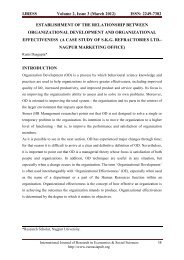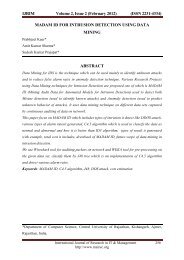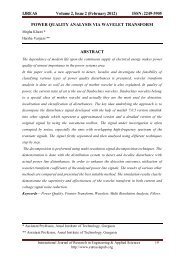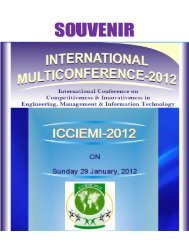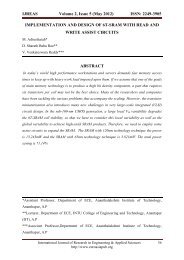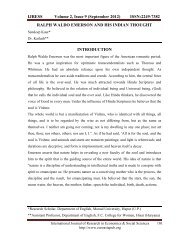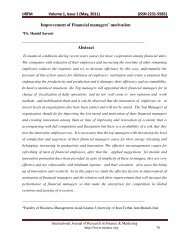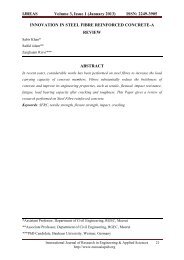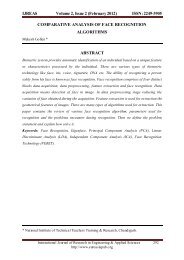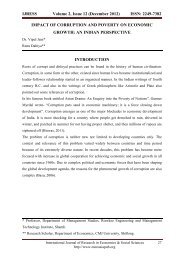study on the growth and yield of mushroom white ... - Euroasiapub.org
study on the growth and yield of mushroom white ... - Euroasiapub.org
study on the growth and yield of mushroom white ... - Euroasiapub.org
You also want an ePaper? Increase the reach of your titles
YUMPU automatically turns print PDFs into web optimized ePapers that Google loves.
IJREAS Volume 2, Issue 4 (April 2012) ISSN: 2249-3905SUBSTRATES PRETREATMENTSPlants extract treatmentThe lignocelluloses wastes (sugar cane leaves, paddy straw <strong>and</strong> wheat straw) were treatedwith neem oil (Azadirachta indica) <strong>and</strong> aqueous extract <strong>of</strong> Ashoka leaves (Saracca indica)(1:3.5 w/v). The aqueous extract <strong>of</strong> Ashoka leaves was prepared as follows:1:5w/v oven dried (50-60*c) ashoka leaves powder was mixed in distilled water. The mixturewas boiled for 2-3 hours <strong>and</strong> filtered through muslin cloth. The aqueous extract <strong>of</strong> ashokaleaves was kept in oven at 80*c for 30minutes to prevent c<strong>on</strong>taminati<strong>on</strong> while <strong>the</strong> supernatantwas discarded. After taking out from oven, <strong>the</strong> aqueous extract <strong>of</strong> ashoka leaves was used forsubstrate treatment. The extract has (1:3.5 w/v) <strong>of</strong> leaves <strong>and</strong> water.Neem oil was obtained from market <strong>and</strong> for pretreatment <strong>of</strong> substrates. differentc<strong>on</strong>centrati<strong>on</strong>s i.e.10,15,20,30,40 <strong>and</strong> 60ml/l <strong>of</strong> both plants extracts were used. These wereused to check <strong>the</strong> efficiency <strong>of</strong> lignocelluloses wastes for <strong>growth</strong> <strong>of</strong> mycelia. The c<strong>on</strong>clusi<strong>on</strong>was <strong>the</strong>n drawn that 20ml/l c<strong>on</strong>centrati<strong>on</strong> <strong>of</strong> ashoka leaves (1:3.5w/v) <strong>and</strong> neem oil treatedwastes sholved better <strong>growth</strong> <strong>of</strong> fungus species. The plants extracts <strong>of</strong> this c<strong>on</strong>centrati<strong>on</strong> were<strong>the</strong>n mixed in 1 liter <strong>of</strong> water at <strong>the</strong> time <strong>of</strong> soaking <strong>of</strong> substrates. The excess water wasdrained out after 24 hours <strong>and</strong> substrates were spread <strong>on</strong> clean platform for about 30 minuteto fur<strong>the</strong>r shed free water. These treated substrates were now ready for fur<strong>the</strong>r spawning.Hot water treatmentHot water was used for sterilizati<strong>on</strong> <strong>of</strong> substrates. <strong>the</strong> substrates were immersed in watercompletely for 20 hours. After this, <strong>the</strong> excess water was chained out <strong>and</strong> <strong>the</strong> substrates werenow dipped in water at temperature 70 - 80*C for <strong>on</strong>e hour. <strong>the</strong> excess water was <strong>the</strong>n againdrained out <strong>and</strong> <strong>the</strong> substrates were spread <strong>on</strong> platform evenly till <strong>the</strong>y cooled <strong>and</strong> were readyfor spawning.Chemical sterilizati<strong>on</strong>In this, each substrate was separately soaked in water (50 l for every 10 kg dry choppedsubstrates) <strong>and</strong> 50 ppm each <strong>of</strong> nuvan <strong>and</strong> bavistin were added.This were kept for 24 hoursafter which excess water was drained <strong>and</strong> <strong>the</strong> substrates were spread <strong>on</strong> platform evenly for1<strong>on</strong>e hour. These sterilized substrates were now ready for spawning.Internati<strong>on</strong>al Journal <strong>of</strong> Research in Engineering & Applied Sciences 40http://www.euroasiapub.<strong>org</strong>



